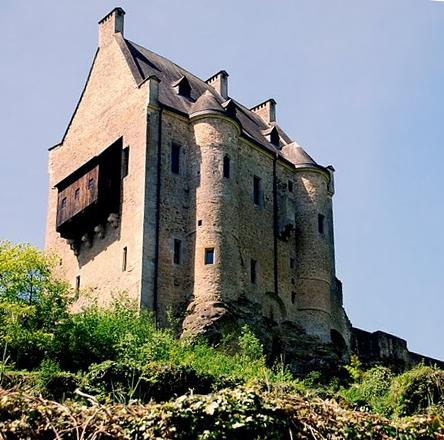Larochette Castle on:
[Wikipedia]
[Google]
[Amazon]
 Larochette Castle (
Larochette Castle (
''Association des châteaux''. Retrieved 10 March 2011.

"The castle of Larochette"
''Larochette: Syndicat d'initiative et de tourisme''. Retrieved 10 March 2011.
File:Larochette Castle - Reconstruction.JPG, Reconstructed model
File:Larochette Castle 1.JPG, Interior
File:LarochetteBlickaufBurg.JPG, Ruins from town centre
File:Château de Larochette, Luxembourg.jpg, East side
 Larochette Castle (
Larochette Castle (Luxembourgish
Luxembourgish ( ; also ''Luxemburgish'', ''Luxembourgian'', ''Letzebu(e)rgesch''; Luxembourgish: ) is a West Germanic language that is spoken mainly in Luxembourg. About 400,000 people speak Luxembourgish worldwide.
As a standard form of th ...
: ''Buerg Fiels'', German
German(s) may refer to:
* Germany (of or related to)
** Germania (historical use)
* Germans, citizens of Germany, people of German ancestry, or native speakers of the German language
** For citizens of Germany, see also German nationality law
**Ge ...
: ''Burg Fels'', French: ''Château de Larochette'') stands high above the town of Larochette in central Luxembourg
Luxembourg ( ; lb, Lëtzebuerg ; french: link=no, Luxembourg; german: link=no, Luxemburg), officially the Grand Duchy of Luxembourg, ; french: link=no, Grand-Duché de Luxembourg ; german: link=no, Großherzogtum Luxemburg is a small lan ...
. Dating from the 11th century, the castle was destroyed by fire at the end of the 16th century. Since its acquisition by the State of Luxembourg in 1979, some restoration work has been undertaken."Le château de Larochette"''Association des châteaux''. Retrieved 10 March 2011.
Location
The castle ruins are located on a promontory some 150 metres above theWhite Ernz
The White Ernz (, , ) is a river flowing through Luxembourg, joining the Sauer at Reisdorf. It flows through the towns of Larochette, Medernach and Ermsdorf. The river valley also includes the notable feature of having a twin castle from the 14t ...
which runs through the small town of Larochette. The access road crosses a large farmyard with fortified earthworks. The main building is surrounded by a wall, now partly destroyed. A deep ditch divides the castle into two parts. At the far end of the promontory, the remains of several manor houses attest to the high quality of the architecture and its rather pompous style.

History
The earliest references to the castle are from the end of the 11th century and during the 12th century when the lords of Larochette ( Van der Feltz) were flag bearers for thecounts of Luxembourg
Count (feminine: countess) is a historical title of nobility in certain European countries, varying in relative status, generally of middling rank in the hierarchy of nobility. Pine, L. G. ''Titles: How the King Became His Majesty''. New York: ...
. The family proliferated leading to the construction of the five stately houses which are separate from the main structure. They include the Homburg Manor (1350) and the Créhange Manor (1385) both of which have now been restored. The ''Verlorenkost'' (literally Lost Food) watchtower also stands alone on the south side. The legend goes that the cook was carrying pots full of food when she stumbled, breaking everything.
The Créhange manor now contains period artwork. There is a well inside which also has its legend, telling how the lady of the castle jumped into the well with her child while the castle was under attack. After rescuing the brave woman, the invaders accused the steward of the castle of treason and threw him into the well. It is said that he reappears every Good Friday in the form of a dragon.
Visiting times
The castle is open to the public from Easter until the end of October, every day from 10 am to 6 pm.''Larochette: Syndicat d'initiative et de tourisme''. Retrieved 10 March 2011.
See also
*List of castles in Luxembourg
By some optimistic estimates, there are as many as 130 castles in Luxembourg but more realistically there are probably just over a hundred, although many of these could be considered large residences or manor houses rather than castles.Evy Friedri ...
Gallery
References
Castles in Luxembourg Tourist attractions in Luxembourg {{Luxembourg-struct-stub